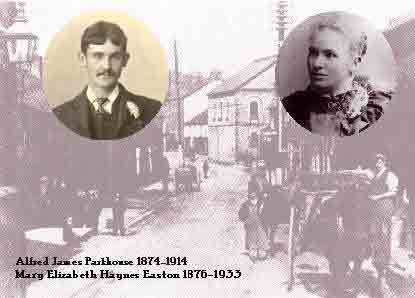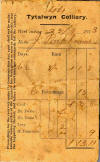
| |
|
|
|
|
|
|
| |
|
 |
|
After their marriage at St
Andrews Church, Rowbarton, Taunton, Somerset, in 1902, Alfred James
and Mary Elizabeth Haynes (nee Easton) Parkhouse moved to Aberkenfig near
Bridgend, Glamorgan.
A pay slip dated 23 August 1913 reveals that Alfred
James worked at Tytalwyn Colliery. When a few months later he died, in
January 1914, his death certificate describes his occupation as Colliery Pumpman. The cause of death was stated to be
"influenza, acute
meningitis, and exhaustion". He was tragically young at the
age of 39. They were living at the time at 22 Dunraven Street, Aberkenfig.
His wife was left to care for their six children, all
under 11 years old, in conditions of extreme poverty. However, Mary
Elizabeth (Polly) although worn out, judging from her
later photos, did raise them all before she
died at the early age of 56 on 7 Sep 1933 at 1a Quarella Road, Bridgend,
Glamorgan, which appears to have been the Workhouse/Infirmary. |
|
|
 
Even
before his marriage, Alfred James had, like very many others, crossed the
Bristol Channel to South
Wales. This is confirmed by his address on the back of a photograph of
him, taken about the date of his 21st birthday (1892), : "No 3 Oxford
Place, Tynewydd, Ogmore Vale". [Of course, the address may be
later than the date of the photograph, which was taken in Bridgwater].
1892 is the same year that the Park Slip disaster occurred, on 26
August, which killed
112
men. But since Ogmore Vale is some 7 miles NNE of Aberkenfig, the
location of Park Slip, he was unlikely to have been directly affected,
but must have been aware of the dangers.
There were
dozens of mines (pits, slants and slips) in the area at the time but
nothing is known of his working life: what
jobs he undertook and where he worked other than that his last job was
as a Colliery Pumpman in Tytalwyn colliery just above Aberkenfig, north
of Cefn Cribbwr. Family lore indicated that he had been injured in a
mine. Perhaps that is why his job was as Colliery Pumpman. There is no
mention of injury on his death certificate.
Now that mining in this area has ceased, it's possible to walk in the
Parc Slip Nature
Reserve, and if you have Google Earth
installed, you can see how green the area around
Aberkenfig is
today, apart from some open-cast mining of some sort to the West, North
of Cefn Cribwr. |
| |
|
|
|
|

1 Mount Pleasant, Aberkenfig, which was one of the former Parkhouse homes sometime between 1910
and 1933.
|
|

A postcard showing Tytalwyn colliery in 1910 and (right) one of
Alfred James Parkhouse's last pay packets, dated 23 August 1913. |
|
 |
| |
|
|
|
|
|
Note how
little pay he received for 6½ days work! It appears the basic rate
was 40d (old pence) a day, with a supplement of some sort, presumably
related to the quality of the coal, bringing the total weekly pay to
£1.14.8d. But then there were deductions: 3d to Dr Davies, 2d levy for
some unknown reason, and finally what I take to be an Industrial Injury
Insurance contribution of 4d, making a total deduction of 9d. His wife
"Polly" would have been handed the unopened pay packet containing
£1.13.11d (£1.70 in modern money) to feed, clothe, and house the
family, which in Alfred James's case was himself, wife and five children
with one "on the way". [30 years before, the average collier's
weekly
wage was 12/6d (62½ new pence) at Cefn Slip, a nearby colliery]. Note also the "get-out" clause written on the
left of the packet: "Proceedings for the Recovery under the Compensation
Act 1906, shall not be maintainable unless notice of the Accident has
been given as soon as practicable after the happening thereof, and
before the workman has left the Colliery."
Just by the way, the other doctor named on the packet is the much respected and
generous Dr Twist of Cefn Cribwr who had only recently married, for the
first time, at the age of almost 50, on 28 February 1912. He died in
Bristol on 5 January 1922 after 30 years in the area.
The Tytalwyn slant, associated with Ton Phillip colliery, had been
opened around 1900 by the Ton Phillip Rhondda Colliery Company. When the
Company got into difficulties around 1913, Tytalwyn was one of the
collieries taken over by Baldwin's. It was nationalised in 1947 and
closed in 1959.
The term "slant" is assumed to be synonymous with "drift" in that the
mine was driven into the side of a hill where the coal outcrops. |
| |
|
|
|
|
| |
|
|
|
|
Sources: "Cefn
Cribwr, Chronicle of a Village" by Neville Granville
published 1980 Stewart Williams, Barry. ISBN 0900807393
http://www.welshcoalmines.co.uk/GlamWest/aberbaiden.htm |
|